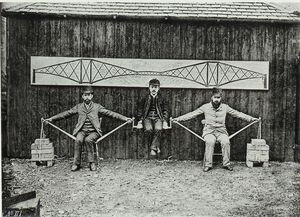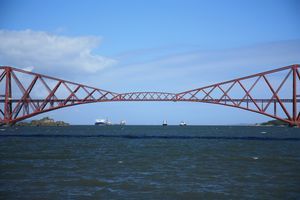Cantilever Bridge Facts, Design and History
Cantilever bridge is a bridge whose main elements are cantilevers (structures that are anchored at only one end while the other projects horizontally into space). These bridges can use beams for smaller (pedestrian) bridges or trusses made of structural steel, or box girders of prestressed concrete for larger bridges that carry road or rail traffic.
First cantilever bridges appeared in 19th century when a need for longer bridges presented itself. To solve the problem of length, engineers of that time found out that many supports would distribute the loads among them and help to achieve length. Predecessors of cantilever bridges were bridges with hinge points that were placed mid-span. The one to be the first to invent and patent a cantilever bridge was Heinrich Gerber which did it in 1866. His first cantilever bridge was the Hassfurt Bridge over the Main River in Germany. It wasn't too impressive by today's standards - it had 38 meters in length but is considered the first modern cantilever bridge. Other early cantilever bridges were the High Bridge of Kentucky, designed by C. Shaler Smith in 1877, the Niagara Cantilever Bridge designed by Charles Conrad Schneider in 1883, and the Poughkeepsie Bridge designed by John Francis O'Rourke and Pomeroy P. Dickinson in 1889. The Forth Bridge, the bridge over the Firth of Forth in the east of Scotland, is one of the most famous early cantilever bridges and it is that with a reason. It is a railway bridge built in 1890 whose full length is 2,528.7 m while its longest span has length of 520 m. It remained the bridge with the longest span in the world until Quebec Bridge wasn't built in 1919 with its span of 549 m.

Today's longest cantilever bridges by their longest span are still:
- Quebec Bridge in Quebec, Canada, a road, rail and pedestrian bridge across the lower Saint Lawrence River and
- Forth Bridge a cantilever railway bridge over the Firth of Forth in the east of Scotland, near of Edinburgh City Centre. Its longest span is 520 m.
- Minato Bridge in Osaka, Japan with its longest span of 510 m. It is a double-deck bridge built in 1973.
- Commodore Barry Bridge over the Delaware River in Chester, Pennsylvania, USA and built in 1974. Its longest span is 501 m and it carries road traffic.
- Crescent City Connection in New Orleans, Louisiana, USA. It spans the Mississippi River and its longest span is 480 m.
- Howrah Bridge spans the Hooghly River in West Bengal, India. It was built in 1942 to carry road traffic and pedestrians and it has a span of 457. It is considered the busiest cantilever bridge in the world because it carries approximately 100,000 vehicles and more than 150,000 pedestrians daily.
- The Gramercy Bridge over the Mississippi River connecting Gramercy, Louisiana in St. James Parish with St. John the Baptist Parish. Built in 1995 with a span of 445 m.
- San Francisco – Oakland Bay Bridge (also known as Bay Bridge) with a span of 427 m. It was built in 1936.
- The Horace Wilkinson Bridge has a longest span of 376 m and was built in 1968.
- The Governor Malcolm Wilson Tappan Zee Bridge that spans the Hudson River at one of its widest points. It was built in 1955 and its longest span is 369 m.
A simple cantilever bridge has two cantilever arms extending from opposite sides of an obstacle that has to be spanned and they meet at the center. Cantilever bridges can be built without false-works below nor temporary supporting towers and cables above. It is one of their great advantages. They are also of very rigid construction so they can carry large loads without threat for construction.

